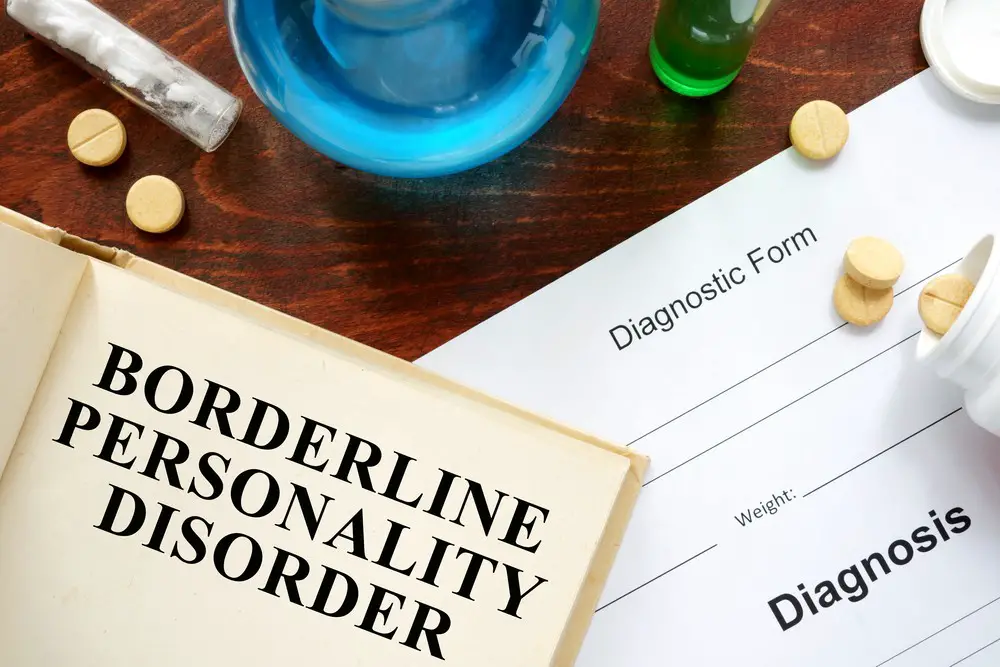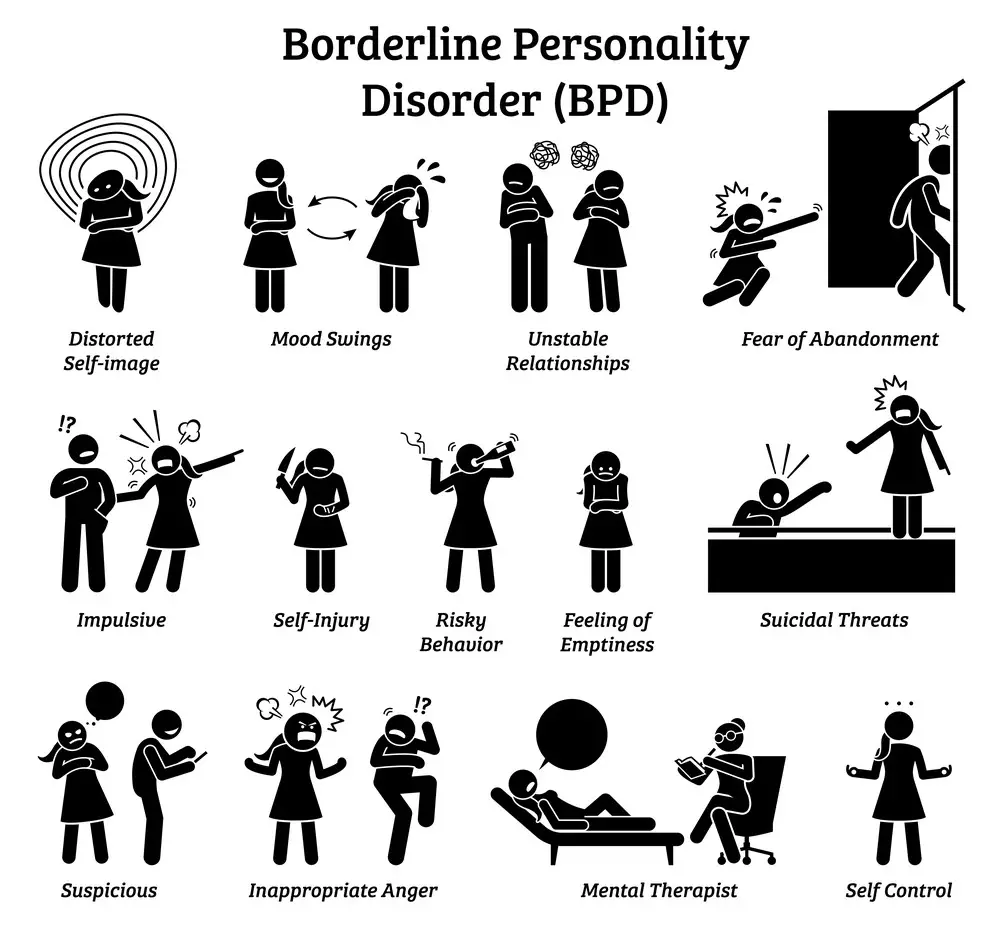As a BetterHelp affiliate, we receive compensation from BetterHelp if you purchase products or services through the links provided
According to the National Education Alliance for Border Line Personality Disorder, BPD affects about 5.9% of adults at some time in their life in the U.S. Even though 75% of the people usually diagnosed are women, research indicates that men may be equally affected but often get misdiagnosed with depression or PSTD.
People with BPD struggle to regulate emotions, creating extended periods of intense feelings after an emotionally triggering event. These ongoing periods of instability affect their behavior, moods, functioning, and self-image, leading to impulsive behavior and unstable relationships. Unfortunately, these intense mood swings and uncertainty result in higher rates of suicidal or self-harming than those seen in the general population.
Borderline personality disorder often proves challenging to diagnose because some co-occurring disorders have overlapping symptoms. For example, the symptoms of BPD match PTSD, depression, bipolar disorder, anxiety disorders, eating disorders, and substance use disorders.
With time, therapy for borderline personality disorder seems to help by decreasing the symptoms. However, although people with BDP are quick to seek therapy and open up, they are likelier to leave treatment or shut down because therapy easily triggers their emotions.
Borderline Personality Disorder Schema Therapy

Borderline personality disorder schema therapy uses elements from cognitive-behavioral therapy with other psychotherapy elements to help identify and change unhealthy ways of thinking.
Schemas are the mental frameworks within the brain made up of memories and unique experiences. However, these schemas can also lead to missing vital information, focusing instead on pre-existing ideas and beliefs. Therefore, these mental frameworks can block out any new information that doesn’t conform to the person’s established ideas and can encourage stereotypes.
Theory of Schema-Focused Therapy
Schemas develop and change, starting early in life and altering according to new experiences and information.
The theory behind schema-focused therapy is to find maladaptive early schemas based on inadequately met childhood needs. These needs include acceptance, love, and safety and can develop into unhealthy interpretations and interactions.
These long-term mental memory models create pervasive patterns of how people think and behave based on their sense of self and how they view the world.
People facing events in their current life that resemble something from their past related to forming a schema will trigger it, resulting in an unhealthy way of thinking and behavior.
Therefore, schema therapy suggests that difficult childhood experiences cause many BPD symptoms.
Examples of Unhealthy Early Schemas

Some examples of early schemas that may lead to issues later include:
- Inadequacy / Shame: The person may believe they are unlovable, leading to them sabotaging their relationships out of fear of being abandoned.
- Emotional Deprivation: The person believes that others won’t meet their needs, often ending up in relationships where they feel emotionally neglected.
- Social Isolation: The person has an early schema that they don’t belong or are unaccepted, often leading them to isolate themselves.
- Enmeshment: The person has a schema that they can only have happiness or success when they have support from others, often family members, leading to them becoming overly dependent. The person will often lack a sense of direction, independence, and individuality.
Schema therapy proposes three main coping styles for dealing with the beliefs from early schemas.
- Surrendering causes people to accommodate the behaviors that reinforce their current beliefs, accepting that that is how things should be.
- Avoiding the people and situations that trigger feelings of vulnerability and disconnecting from their emotions.
- Overcompensating by fighting against the schema to prove it’s not true. Acting in opposition to beliefs can often lead to extreme behaviors.
These coping methods often provide short-term relief but help perpetuate the schemas long-term.
Goals of Borderline Personality Disorder Schema Therapy
The initial goals of borderline personality schema therapy are to help the patient identify the relevant schemas and learn to link them to past events and their current symptoms.
The patient works with the therapist to process the emotions related to the schemas identified. Then, they work on altering their coping styles that cause the symptoms of their BPD.
Schema therapy uses several techniques during treatment, usually based on individual needs. Schema therapists aim to make their patients feel comfortable and safe.
Healthline highlights the techniques of borderline personality disorder schema therapy into the following categories:
Therapists use several techniques for schema therapy, but these fall under two basic concepts therapists use emphatic confrontation and limited reparenting. Both concepts work best when the person feels comfortable and safe with their therapist.
Empathic confrontation – The schema coming up in therapy is confirmed by the therapist, helping the person to realize the need for change in an empathetic and understanding manner.
Limited reparenting – The therapist offers limited reparenting aligning with ethical standards to help fulfill the emotional needs lacking in the person since childhood.
The four categories generally used to carry out these two concepts include:
- Emotive
Emotive techniques like role-playing and imagery entail using emotions to Emotive techniques involve using emotions to help combat schemas. They allow people to experience emotions in their entirety and express them to their therapist in safety.
- Interpersonal
Interpersonal techniques help examine the person’s relationships, identifying similar patterns to the responses and how these affect them. Sometimes the therapist will ask the person to bring their friend or partner to the therapy.
- Cognitive
A therapist uses cognitive techniques to help identify and challenge harmful thought patterns resulting from schemas. During therapy, structured conversations and other means help review the person’s life experiences to find evidence supporting or contradicting the schema.
- Behavioral
Borderline personality disorder schema therapy also uses behavioral techniques, helping people learn how to change their behavior patterns that best suit their coping style. For example, they talk the person through problematic situations or use role play to find positive solutions. People are encouraged to practice some of the exercises between therapy sessions.
Effectiveness of Schema Therapy
Schema therapy is relatively new, meaning long-term studies on its effects are still pending. However, researchers in several studies say the results treating several personality disorders, including borderline personality disorder, have shown promise.
Despite existing research results, experts await further trials on the effectiveness of schema therapy for borderline and other personality disorders.
Tips to Improve Borderline Personality Disorder Schema Therapy
1. Talk openly and honestly about your feelings with your therapist. Open communication is essential for successful therapy outcomes.
2. Create a safe space to relax and feel secure during sessions. This could include having a cozy blanket or pillow or bringing calming music to listen to before the session.
3. Record your thoughts and feelings throughout the day as they arise (even if only for a few moments). Use this record to monitor how schemas affect your behaviors and reactions, then bring this up during therapy sessions.
4. Practice relaxation techniques like deep breathing, yoga or meditation outside of therapy sessions when feeling overwhelmed by emotions related to schemas.
5. Make a list of positive affirmations to remind yourself of your self-worth when feeling overwhelmed by shame or guilt related to schemas.
6. Reach out for support from close friends and family during difficult times, whether for someone to talk to or help with practical tasks.
7. Create a plan ahead of time on how you can manage intense emotions that come up during the day so as not to be taken by surprise if they arise unexpectedly.
These tips are all important aspects of successful Borderline Personality Disorder Schema Therapy. By being open, honest, and connected throughout the process, people have a better chance of succeeding at overcoming their schemas and leading healthier lives.
Final Take
Schema therapy for borderline personality disorder requires long-term commitment, which can be costly for someone without insurance. The American Psychological Association provides a therapist finder, making it easier for someone to find a schema therapist near them. Since schema therapy draws heavily from CBT, many CBT therapists have experience working with the core principles of borderline personality disorder schema therapy.



